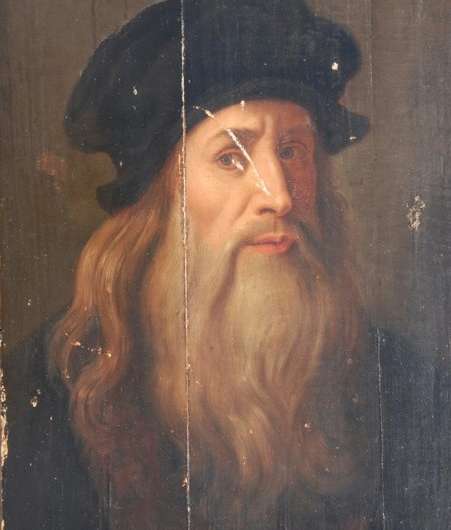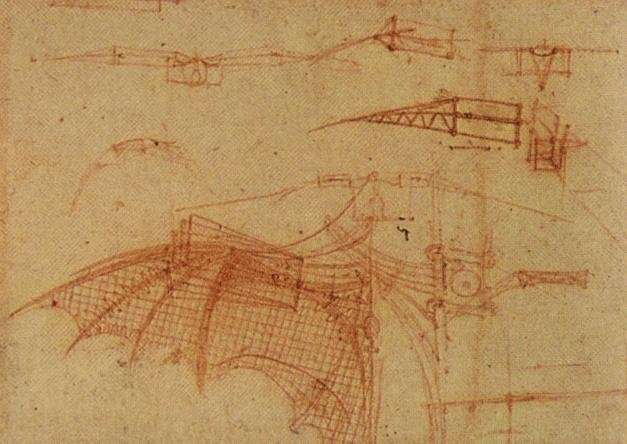Self portrait of Leonardo do Vinci.
Although Leonardo da Vinci (1452-1519) is known to have studied bird flight, few people realise that he was the first to document flight maneuvers, now called dynamic soaring. Birds use these maneuvers to extract energy from wind shear for sustained flight. A recent paper published in Notes and Records explores Leonardo's early description of dynamic soaring, which is one of his major aerodynamic discoveries. This predates, by almost 400 years, the first generally-accepted explanation of the physics of this soaring technique by Lord Rayleigh in 1883. We spoke to the author, Professor Dr Philip Richardson.
How did you become interested in Leonardo da Vinci?
I first saw soaring albatrosses on an oceanographic cruise to the South Atlantic. As we left Cape Town and the ship steamed straight upwind into 15 knots of wind, I watched a wandering albatross coming from astern overtake us and then fly parallel to our ship. At no time did the bird flap its wings. I became curious as to how a bird could soar directly into the wind like that. Eventually I discovered that the albatross was using the increase of wind speed combined with height above the ocean surface or wind shear in what is called dynamic soaring. I wondered who had first discovered dynamic soaring and became interested in its early history. I knew that Leonardo had studied birds soaring in winds and decided to read his notebooks to see what he had found out. It turns out he had sketched and described the dynamic soaring technique of land birds over 500 years ago. Most scientists believe that Lord Rayleigh was the first to describe how a bird could gain energy from wind shear to soar, but Leonardo appears to have made this discovery much earlier.
How did Leonardo become interested in aviation?
Leonardo first worked with models of flying devices in the workshop of Andrea del Verrocchio in Florence as described by Domenico Laurenza in his book "Leonardo on Flight." Various contraptions like giant birds and winged dragons that "flew" on cables were created in order to amaze the audiences of theatrical productions. Leonardo was also interested in birds, studying how birds flapped their wings, how they controlled their flight with their wings and tail, and how they were able to soar in wind without flapping their wings. This seems to have led him to try and build a human powered flying machine with flapping wings, which we now call an ornithopter. He studied the strength of humans and tried to figure out how to power an ornithopter's wings using a person's strength and mechanical leverage. He also sketched and designed gliders. Many working models of these devices have now been built and can be seen in museums and books.
Design for a flying machine date circa 1505. Credit: Wikipedia
Leonardo observed flying birds in the hills near Fiesole outside of Florence as described in his "Codex on the Flight of Birds" circa 1505. His sketches of flying birds are located in several notebooks, where he carefully described their flight patterns. After he realised how difficult it would be for a human to power an ornithopter, he seems to concentrate on the details of soaring birds to discover how they flew without flapping their wings. Although he probably wanted to use this information to power a flying machine, there is no evidence he was successful in doing so. The last notebook he started, "Manuscript E" (circa 1513-1515), best summarises his studies of soaring flight and clearly shows how migrating birds use the wind for long range soaring.
How much of an impact do you feel Leonardo's sketches on aviation have influenced the first successful aviation machines?
Leonardo was busy with his art projects, his numerous scientific studies, and his technology developments that he never got around to organising and publishing his discoveries. His descriptions of bird soaring and aerodynamics remained in his notebooks generally unknown to others who were later developing flying machines. Leonardo's Codex "On the Flight of Birds" was published in 1893 in France. Although several people were experimenting with gliders and powered flight at that time it is not apparent that Leonardo's work on the aerodynamics of flying birds ever influenced these people. The Wright brothers appear to have done their own research on flight and not been influenced by Leonardo's. Only fairly recently have pilots of radio-controlled gliders become interested in using wind shear to power their gliders. The extremely fast flight of these gliders at over 500 miles per hour has recently caught people's attention and publicised how powerful dynamic soaring can be. Virtually all modern references to dynamic soaring mention Lord Rayleigh's 1883 description and not Leonardo's work. This is probably because recent translations of Leonardo's notebooks often omit his sketches of dynamic soaring, and historians are mostly unaware of what dynamic soaring flight patterns might look like. In my own case I had been interested in soaring flight for many years, studied the flight of albatrosses, and easily recognised that Leonardo's sketches and notes described dynamic soaring. In order to let others know about Leonardo's discovery I described his observations.
Are there any other areas of Leonardo's interests, which you would like to study further?
I would love to study Leonardo's discoveries about bird soaring by retracing his steps and trying to observe and sketch the birds he observed and sketched. I would like to visit Florence where he worked for a number of years, explored the nearby hills of Fiesole, and watched birds flying. And of course I would like to visit Vinci near where he was born, Milan where he worked, and Rome where he wrote his last notebook, which includes excellent sketches of dynamic soaring flight and best describes it. And of course I would like to visit the various museums and libraries that are dedicated to Leonardo and his work and to further study his remarkable discoveries.
Provided by The Royal Society

























